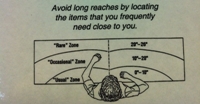While the ability to stand and function on two legs allows humans to excel at home, work, sport or play, it is also a set-up for failure at the foundation or hub of the body; the lower back.
1. POOR POSTURE- Whether you’re sitting, standing or sleeping, poor posture can accelerate the rate of onset of Low Back Pain, and problems. Correct posture involves one that maintains the 3 normal curves of the spine. Flexibility and strengthening exercises can help you maintain your proper posture throughout the day.
The basis of good standing posture can be remembered and practiced by imagining there is a rope attached to the top of your head that pulls upward toward the sky and helps you stand erect. When this is correct a straight line would fall through the ear, shoulder, hip knee and ankle. To encourage this, tuck your chin in a bit, tuck your belly button up and in and imagine elongating the height of your body. Good standing posture reduces fatigue, stress on the spine, and prevents potential back problems.
Good sitting posture involves sitting on the front of your sit bones and more on  the backs of your thighs than on your buttock. Think of sitting on a chair or in a car like you sit on the toilet; on the backs of your thighs. You never sit on your sit bones on the toilet!
the backs of your thighs than on your buttock. Think of sitting on a chair or in a car like you sit on the toilet; on the backs of your thighs. You never sit on your sit bones on the toilet!
2. FAULTY BODY MECHANICS- Faulty body mechanics is one of the leading causes of back injuries.When performing work or household activities, proper lifting and bending techniques can help minimize risk of injury. Your physical therapist can teach you the correct technique for each and every activity. Each patient that comes to SWOPT receives a Lower Back Care Manual. to use as a reference once you are discharged from physical therapy. However, correcting faulty body mechanics and developing good habits will take a concentrated effort on your part throughout every day to get the best result.
3. POOR WORKING HABITS- Making alterations to your work station at home or at work can significantly help reduce the risk of low back injury. This may include adjusting the height of the work station, the amount of support in your chair, or the way you lift, and/or the where you lift from.Your physical therapist can make recommendations for your particular work environment which will speed the rate of your recovery and reduce the risk of re-injury or the chance of acquiring chronic back problems.
4. POOR FLEXIBILITY- A loss of flexibility and the onset of muscle imbalances limits the extent that your body can move safely. This mostly occurs with jobs involving daily prolonged sitting, but can also occur in the absence of prolonged sitting. Characteristically what occurs is that muscles on the front of the body tend to shorten and become tight, and muscles on the back of the body(including lower back muscles) tend to overstretch and become weakened. These muscle imbalances cause you to be unable to assume proper positions for lifting, bending, and/or stooping and thus set patients up for low back sprains and strains. A routine of regular muscle imbalance stretching exercises prescribed by your physical therapist can improve your flexibility and minimize risk of re-injury.
5. POOR PHYSICAL CONDITIONING- People in poor physical health are more prone to low back injuries than those that exercise regularly. By allowing a physical therapist to design a combined aerobic exercise, core strengthening, and muscle imbalance stretching program for home, you will not only reduce your risk for low back injury, but also prevent chronic diseases such as heart disease, diabetes, and high blood pressure.
Physical Therapists are trained to educate and we at SWOPT are committed to providing you with as much information as you need to not only recover from your injury or condition, but to also prevent reoccurrence. That’s all for now.





